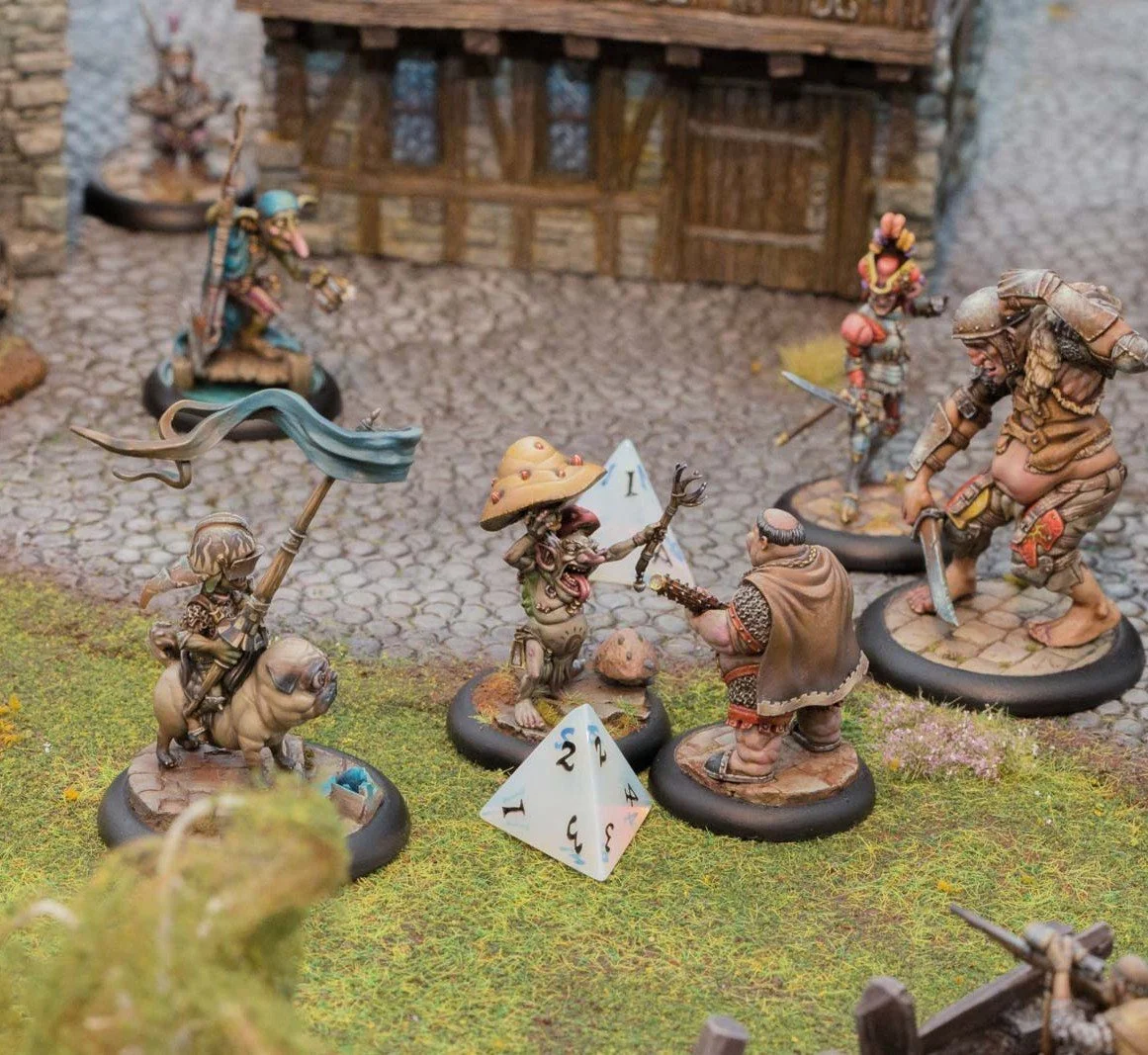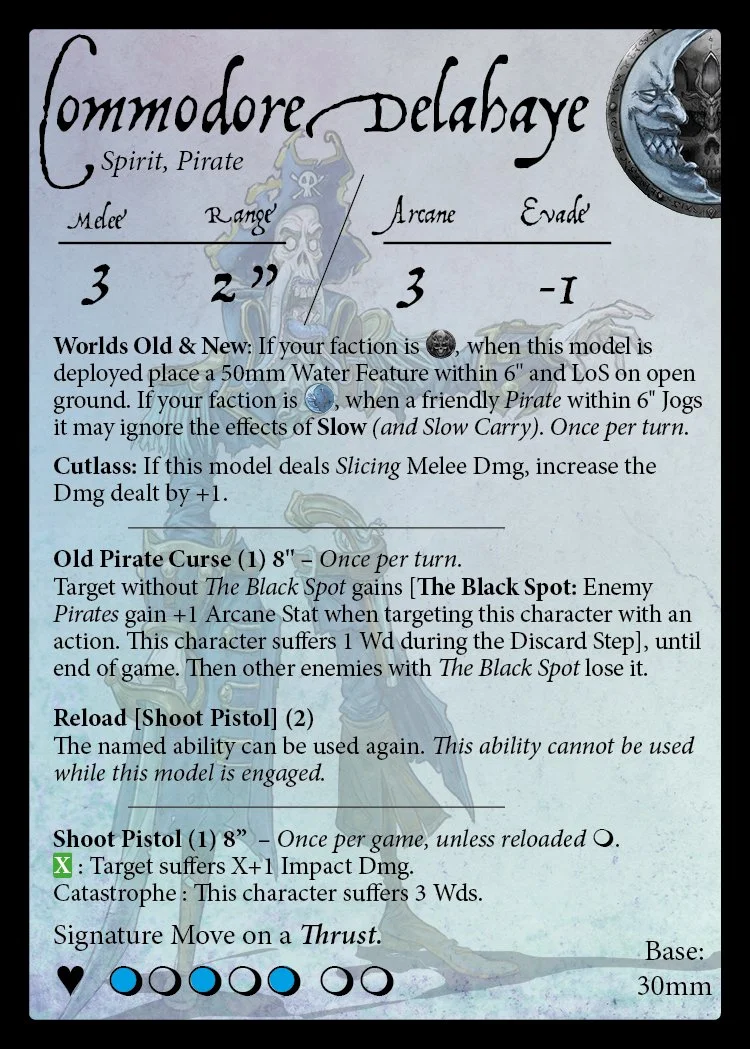Common Mistakes New Players Make
I’ve been working with Tom since around 2019 on Moonstone lore, marketing, and a variety of other bits and pieces. I’ve had Moonstone minis on my painting table for even longer (I may not be an amazing painter, but I really enjoy it!).
But until the last year-or-so I’ve not been a part of a gaming group that had the time and inclination for Moonstone (I’m a TTRPG-er and board gamer and some of those friends didn’t want to play with war dollies - you know how it is!). I’m pleased to say that has now changed and I’m happily also running regular events at our local gaming cafe in Basingstoke.
That’s meant I’m relatively new to actually playing the game, even though I know the lore very well and had an overview of the basics for a long time. I wanted to share some of my most common mistakes and things I’ve forgotten, so that those who are new to this amazing skirmish game can learn from my errors!
Cover, Line of Sight, and Peeking Round Something That’s in the Way
Characters need to have Line of Sight on their ally or enemy in order to target them (pages 21, 24 and 25 of The Rulebook give the details), so it’s important to agree what is an Obstacle or a Barrier, or a single tree vs a Wooded Patch with your opponent. This is particularly important if a character would benefit from one of these types - for example, so they can try out Bristlenose with a Water Feature if they’ve only just bought him!
One element I tend to forget though: it’s possible to bypass cover modifiers. Your character needs to be within 1 inch of an Obstacle that’s less than 3 inches long (and viably could be seen over / around), or within 1 inch of an ally (to lean past them). This means Flintlock can fire over a low wall, or Jayda could shoot past Jackalope if they’re close enough.
Peggy can bypass any cover granted by the edge of this little boat, as she pops up to shoot at Sen’Ara. Conversely, Sen’Ara would still suffer penalties because of the cover granted by the edge of the boat.
“Left… Right… Left… See, I am perfectly in charge of these feets.”
Reaction Steps: Who and When
Don’t forget to use them, for one! Reaction Steps can be taken once an opponent has taken an action and it has been fully resolved (this includes a free jog, making a melee attack, or using an ability - anything!). The player to their left takes a Reaction and so on. Only one model per opponent can do this and only once per Action.
Distractions: Being Crowded During Combat
I often forget that for every Enemy that’s engaging your character, you draw 1 fewer Melee card. This is particularly important when you or an opponent is playing with Boris the Bunny Summoner, or any Shades character that can summon a Pomp. Those little Baaaaa…abelings can be rather annoying for this reason alone!
In this image the Friar is not only in Shabbaroon’s melee range but also Doug’s. If Gotchgut were in the Dominion troupe, then that would be three enemies for the Friar to face and would mean he’d need to do a lot of spanking…
When to Shuffle
“I thought I saw something - never mind!”
My instinct is to shuffle the decks whenever I pick them up; while this is fine for the Melee Deck, this should be avoided for the Arcane Deck. The rules tell us to shuffle the Arcane Deck after a round of Arcane has been completed, and I strongly recommend trying to get into the habit of that. As characters like Liv can manipulate the deck this will avoid an accidental shuffle when the deck has been tinkered with. I’d do this regardless of whether there is a character on the table that can manipulate the deck or not, as it’ll get you into good habits.
If you find this habit isn’t sticking, Tom and Joe have taken to putting any cards placed on top of the Arcane Deck at 90 degrees sideways to act as a reminder not to reshuffle.
Stuff Stacks: Abilities
There’s logic behind many character abilities, but unless a card says otherwise conditions, effect etc. will stack. Three examples for you:
“I recommend you cover your ears, My Queen.”
Banshee’s ‘Ear Splitting Screech’ ability causes ‘Bleed’ until the end of the Discard Step. It’s only Energy capacity and the luck of the Arcane-draw that stops this from being applied multiple times to the same enemy, but it could be applied multiple times if you are lucky!
Commodore Delahaye has ‘Old Pirate Curse’ that is applied to an Enemy, but the card makes it clear that once it’s applied to a new target it’s removed from the old.
Liv can give an ally 'Protection’ via ‘Reading the Runes’, which means the first time the character would suffer Damage, it is negated entirely. A character is only initially hit by damage once, so logic says this isn’t something that can be applied to the same character multiple times.
Stuff Stacks: Critical Hits and Upgraded Attacks
If you’re able to play multiples of the same Melee Card this is classed as a Critical Hit. If you choose to upgrade to your character’s special attack, a lot of this is multiplied too; specifically:
Damage or wounds dealt/reduced, wounds restored, distances moved, stats modified, energy gained/lost and abilities gained - all this is multiplied
Anything else, such as range, is not multiplied
Where an ability says for a character to lose “half” (e.g. Wounds or Energy), this is applied in stages: i.e. halved then halved again.
“I will only ask politely once: move!”
For example:
Your active character is Eric the Enlightened. You play two Sweeping Cut cards and upgrade to your special attack: Swinging Antlers. Your opponent plays a Falling Swing, so you deal 6 Impact damage to them (2 x 3 Damage from the upgraded card). If they survive, you then move them 2 inches (2 x ‘move the opponent 1 inch’) in whatever direction you so choose.
As another example:
Your active character is Olim. You play three Low Guard cards and choose to upgrade to Olim’s signature: Fetch! You deal no damage, Olim takes damage from his opponent, then Olim’s End Step triggers. Bjorn is 4 inches away, while Young Jack is 6 inches away. You can’t reach Young Jack because the End Step Effect only allows you to reach characters within 4 inches. However, you can move Bjorn up to 9 inches towards the enemy, plus move Olim up to 9 inches away.
“It ain’t about how hard you hit... Nope, I’m lying, PUNCH ‘EM HARDER CRUSTY!”
And one more:
Your active character is Crusty Balboa and you have used both ‘Pinch’ and ‘Punch’ this turn. You play three Rising Attack cards and upgrade to: First of the Month! Your opponent plays a Falling Swing, so you deal 4 Impact damage to them (3 x 1 Damage from the upgrade plus 1 because it’s Impact Damage, which Crusty favours). During the End Step, you deal 6 Wounds to the enemy, who then can’t make another Melee attack against Crusty (should they want to!).
An Important Distinction: Wounds vs Damage
This upgraded High Guard signature move negates all Damage being dealt and suffered.
To use an analogy here: ‘Damage’ is how large a wave is on the ocean, while ‘Wounds’ is how wet you get. Damage is therefore how hard you get hit, while Wounds is how hurt you are.
Armour, shields and similar will reduce Damage, resulting in Wounds after reduction. Some abilities can also cause Wounds directly and these cannot be reduced making these abilities deceptively powerful. After modifiers it’s possible to inflict 0 Wounds (see this as a bruise Fancyhat gets through his armour). Some Signature Move End Step Effects say “if you 1 or more Wd, X happens”. This means if you inflicted 1 Damage, but it was reduced to 0 by an armour, no Wounds end up being inflicted and the End Step Effect does not happen.
“Within”
Abilities and movement that say “Within” mean measuring from the edge of the triggering character’s base to nearby enemies. If even a small sliver of the enemy’s base is inside this range, then they’re affected by the ability. Similarly, a ‘Step’ measures edge-to-edge on a character’s base, whereas ‘Place Within’ measures the relevant distance and the character’s base can end anywhere inside that distance. Here’s a diagram to explain further:
On the left is an example of a Step of 1 inch, which on the right is ‘Place Within’ 1 inch. You can see the distance on the right is in fact further, despite the distances being the same.
The Only Costs are Energy
“Nappy naps time! I hope you have sweet dreams…”
Some abilities say “do X and achieve Y”, but there is no requirement to “do X” if you aren’t able to. You can’t choose to ignore the instruction however, unless the wording says “may”.
For example, Toodles and Nanny have an ability called ‘Lullaby’ that says: Target model must discard half its energy rounding up, then it restores 2 Wounds. If a model doesn’t have any energy left, it will still restore wounds as part of this ability.
I’ve got to the end of my list of my most common mistakes and I hope you’ve found it helpful. I find the FAQs are really helpful as a reminder of various bits that my brain refuses to retain, so do check that out if you haven’t already. And of course - Moonstone is so easy to play, that most rules do now stay in my head! I just need the odd bit of help now and again…
Happy gaming folks!


















